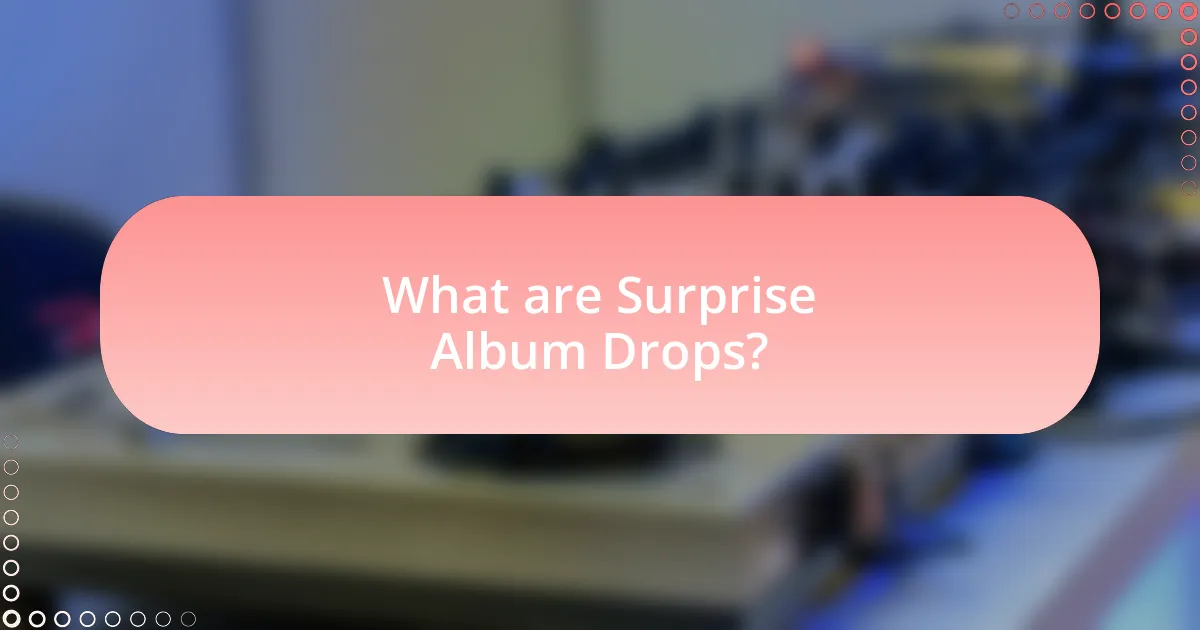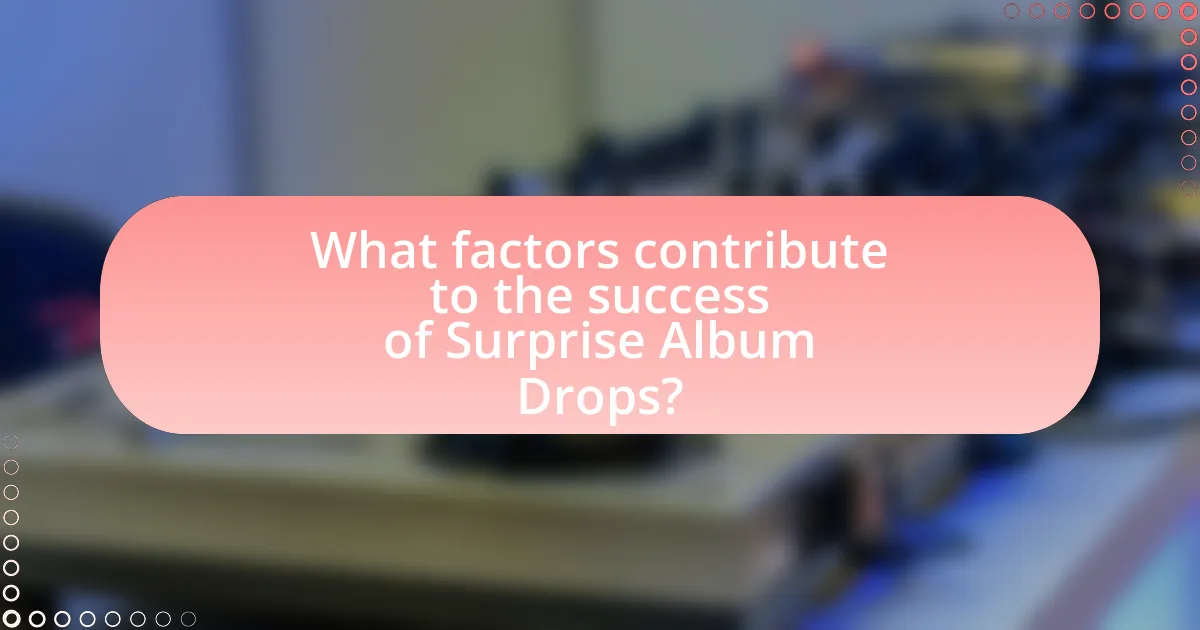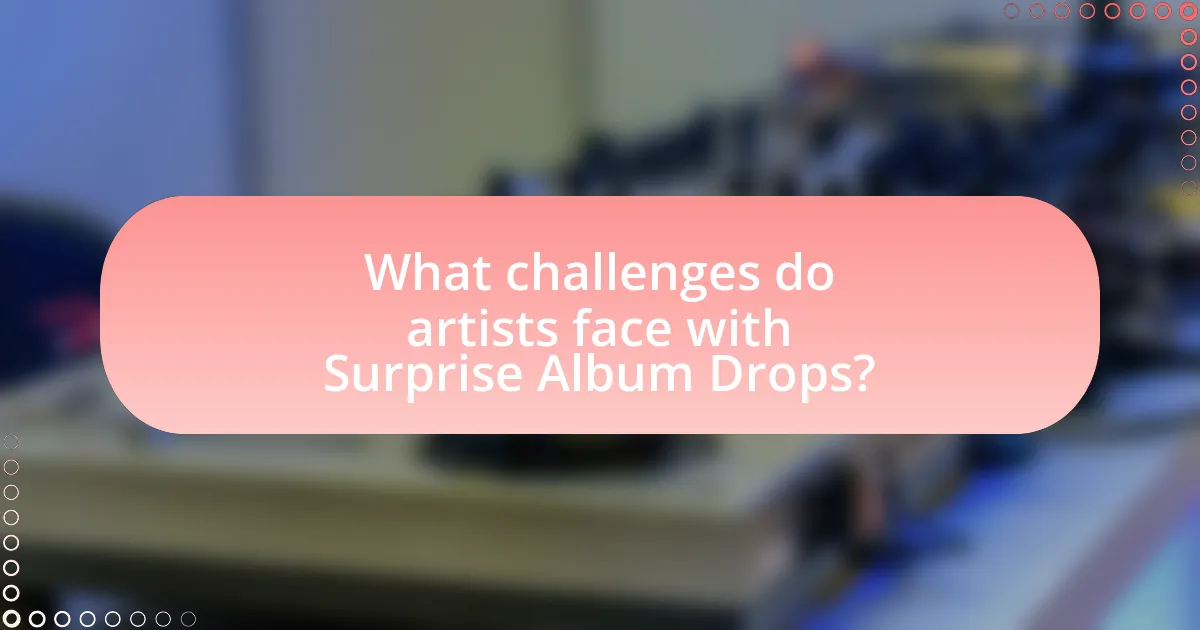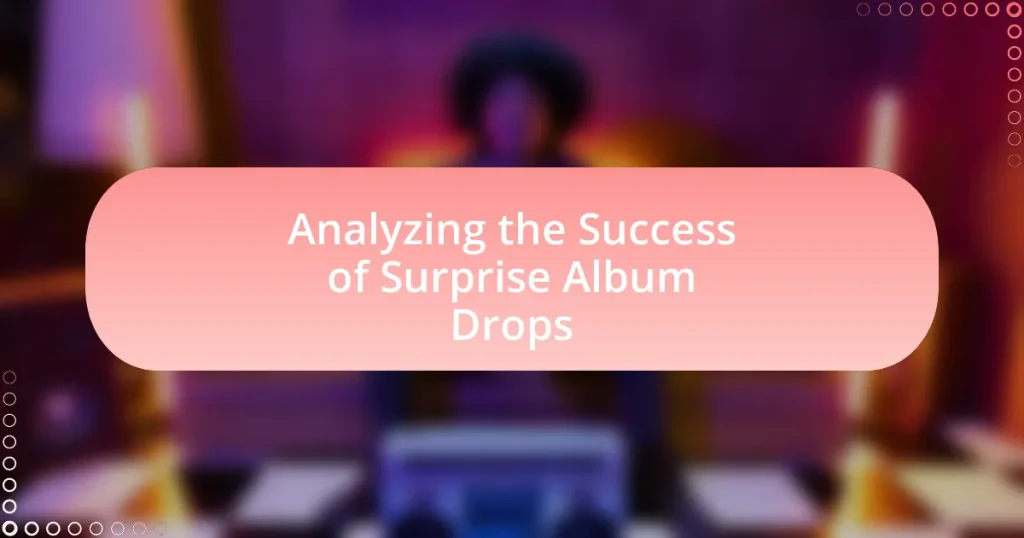Surprise album drops are music releases that occur without prior announcement or promotion, creating immediate buzz and excitement among fans. This article analyzes the effectiveness of this marketing strategy, highlighting key characteristics, differences from traditional releases, and the evolution of surprise drops in the music industry. It examines successful case studies, such as Beyoncé and Taylor Swift, and discusses the advantages and challenges artists face with this approach. Additionally, the article explores the impact of timing, social media, and audience research on the success of surprise album drops, providing insights into best practices for artists looking to engage their fanbase effectively.

What are Surprise Album Drops?
Surprise album drops are music releases that occur without prior announcement or promotion, catching fans off guard. This strategy has gained popularity among artists as it creates immediate buzz and excitement, often leading to higher streaming numbers and sales upon release. For instance, Beyoncé’s self-titled album in 2013 was released unexpectedly, resulting in over 800,000 downloads in its first three days, demonstrating the effectiveness of this approach in engaging audiences and maximizing initial impact.
How do Surprise Album Drops differ from traditional album releases?
Surprise album drops differ from traditional album releases primarily in their marketing strategy and timing. Traditional album releases typically involve extensive pre-release promotion, including singles, music videos, and interviews, which build anticipation over months. In contrast, surprise album drops are announced with little to no prior notice, often leveraging social media to create immediate buzz and excitement. For example, Beyoncé’s self-titled album in 2013 was released without prior announcement, resulting in significant media coverage and sales, demonstrating the effectiveness of this approach. This method can lead to a more immediate and intense fan engagement, as seen in the case of Taylor Swift’s “Folklore,” which was released suddenly in July 2020, achieving over 800,000 sales in its first week.
What are the key characteristics of a Surprise Album Drop?
A Surprise Album Drop is characterized by its unexpected release, often without prior announcement or promotion. This strategy creates immediate buzz and excitement among fans, leveraging social media for rapid dissemination of information. Notable examples include Beyoncé’s self-titled album in 2013, which was released without any prior marketing, resulting in over 600,000 sales in its first week. Additionally, surprise drops often feature a cohesive artistic vision, allowing artists to present a complete body of work that resonates with listeners. The element of surprise not only enhances engagement but also challenges traditional album release models, as seen in the success of artists like Frank Ocean and Drake, who have utilized this approach to great effect.
How has the concept of Surprise Album Drops evolved over time?
The concept of Surprise Album Drops has evolved significantly since its inception, transitioning from rare occurrences to a mainstream marketing strategy in the music industry. Initially, surprise releases were infrequent, with notable examples like Radiohead’s “In Rainbows” in 2007, which allowed fans to pay what they wanted, challenging traditional pricing models. Over time, artists such as Beyoncé and Drake adopted this approach, leveraging social media to create buzz and immediate engagement, as seen with Beyoncé’s self-titled album in 2013, which was released without prior announcement and achieved commercial success. This evolution reflects a shift in consumer behavior, where instant access and novelty drive engagement, supported by data showing that surprise releases often lead to higher first-week sales and streaming numbers compared to traditional album rollouts.
Why are Surprise Album Drops becoming popular among artists?
Surprise album drops are becoming popular among artists primarily due to their ability to create immediate buzz and engage fans without the extensive marketing campaigns typically associated with album releases. This strategy allows artists to capitalize on the element of surprise, generating excitement and discussion on social media platforms, which can lead to increased streaming numbers and sales. For instance, Beyoncé’s surprise album release in 2013 led to over 800,000 downloads in just three days, demonstrating the effectiveness of this approach in driving consumer interest and engagement. Additionally, surprise drops can help artists maintain creative control and avoid leaks, as they can release music directly to fans without prior exposure.
What advantages do artists gain from releasing albums unexpectedly?
Artists gain several advantages from releasing albums unexpectedly, including heightened public interest and increased media coverage. This strategy creates a sense of urgency and excitement among fans, leading to immediate sales spikes and streaming activity. For instance, Beyoncé’s surprise album release in 2013 resulted in over 800,000 copies sold in the first three days, demonstrating the effectiveness of this approach. Additionally, unexpected releases can minimize pre-release criticism and allow artists to control the narrative surrounding their work, as seen with artists like Frank Ocean, who utilized this method to maintain artistic integrity and engage directly with their audience.
How do Surprise Album Drops impact fan engagement?
Surprise album drops significantly enhance fan engagement by creating immediate excitement and fostering a sense of community among listeners. When artists release albums unexpectedly, it generates buzz on social media platforms, leading to increased discussions and interactions among fans. For instance, Beyoncé’s surprise album “Lemonade” in 2016 resulted in a 200% increase in Twitter activity related to her, demonstrating how such drops can amplify fan conversations and engagement. Additionally, surprise releases often lead to higher streaming numbers in the initial days, as fans rush to listen, further solidifying their connection to the artist and the music.

What factors contribute to the success of Surprise Album Drops?
The success of surprise album drops is primarily driven by strategic marketing, fan engagement, and the element of surprise. Strategic marketing involves leveraging social media and digital platforms to create buzz without traditional promotional methods, as seen with artists like Beyoncé and Frank Ocean, who have effectively utilized these channels to maximize reach. Fan engagement plays a crucial role, as surprise releases often foster a sense of community and excitement among listeners, encouraging immediate streaming and sharing. The element of surprise itself generates curiosity and urgency, leading to higher initial sales and streaming numbers. For instance, when Taylor Swift released “Folklore” unexpectedly, it achieved over 800,000 album-equivalent units in its first week, demonstrating the effectiveness of these factors in driving success.
How does timing influence the success of a Surprise Album Drop?
Timing significantly influences the success of a Surprise Album Drop by determining audience engagement and media coverage. When artists release albums unexpectedly during periods of high public interest, such as holidays or significant cultural events, they maximize visibility and listener engagement. For instance, Beyoncé’s surprise album “Lemonade” released in April 2016 coincided with a cultural moment surrounding discussions of race and feminism, leading to substantial media attention and commercial success. Additionally, releasing an album at a time when competitors are less active can enhance its chances of chart success, as seen when artists strategically avoid major release dates. Thus, effective timing can amplify both the immediate impact and long-term success of a Surprise Album Drop.
What role does social media play in promoting Surprise Album Drops?
Social media plays a crucial role in promoting surprise album drops by facilitating immediate communication and engagement between artists and fans. Platforms like Twitter, Instagram, and TikTok allow artists to create buzz and excitement through strategic posts, teasers, and direct announcements, often leading to viral trends. For instance, when Beyoncé released her surprise album “Lemonade” in 2016, social media was instrumental in amplifying the conversation and driving streaming numbers, resulting in over 600,000 album sales in its first week. This demonstrates that social media not only enhances visibility but also significantly impacts sales and streaming performance during surprise releases.
How can an artist’s previous work affect the reception of a Surprise Album Drop?
An artist’s previous work significantly influences the reception of a Surprise Album Drop by establishing expectations and credibility among listeners. For instance, if an artist has a history of critically acclaimed albums, fans are more likely to approach a surprise release with enthusiasm and trust in its quality. Conversely, if an artist’s past work has been poorly received, skepticism may arise, leading to a more cautious or negative reception. Historical examples include Beyoncé’s self-titled surprise album in 2013, which was met with widespread acclaim due to her established reputation, while other artists with less consistent track records may not receive the same level of excitement or acceptance.
What marketing strategies are effective for Surprise Album Drops?
Effective marketing strategies for surprise album drops include leveraging social media platforms, utilizing influencer partnerships, and creating exclusive content. Social media platforms like Twitter and Instagram allow artists to generate buzz quickly, as seen with Beyoncé’s surprise album “Lemonade,” which garnered significant attention through strategic posts and teasers. Influencer partnerships can amplify reach; for instance, when artists collaborate with popular figures to promote their drops, it enhances visibility and engagement. Additionally, offering exclusive content, such as behind-the-scenes footage or limited merchandise, can incentivize fans to engage immediately, as demonstrated by Taylor Swift’s surprise releases that often include unique fan experiences. These strategies collectively create a sense of urgency and excitement, driving immediate sales and streaming numbers.
How can artists leverage exclusivity to enhance the success of their Surprise Album Drops?
Artists can leverage exclusivity by creating limited-time offers or exclusive content that enhances the anticipation and perceived value of their Surprise Album Drops. For instance, releasing a special edition of the album with unique artwork or bonus tracks available only for a short period can drive urgency among fans. Historical examples include Beyoncé’s self-titled album, which was released without prior announcement and included exclusive visuals, leading to significant sales and streaming numbers. This strategy not only boosts initial sales but also fosters a sense of community among fans who feel they are part of an exclusive experience, thereby enhancing overall success.
What are some successful case studies of Surprise Album Drops?
Beyoncé’s self-titled album released in December 2013 is a prominent case study of a successful surprise album drop. The album was released without prior announcement, leading to immediate commercial success, selling over 800,000 copies in its first three days and eventually achieving multi-platinum status. Another significant example is Drake’s “If You’re Reading This It’s Too Late,” which dropped unexpectedly in February 2015 and debuted at number one on the Billboard 200, selling over 495,000 copies in its first week. These cases illustrate how surprise album releases can generate significant buzz and sales, leveraging the element of surprise to engage audiences effectively.

What challenges do artists face with Surprise Album Drops?
Artists face several challenges with surprise album drops, primarily related to marketing, audience engagement, and distribution logistics. The lack of prior promotion can lead to limited initial visibility, making it difficult for artists to reach their target audience effectively. Additionally, without a traditional rollout strategy, artists may struggle to generate buzz and media coverage, which are crucial for maximizing album sales and streaming numbers.
Moreover, the sudden release can create logistical issues, such as coordinating with streaming platforms and ensuring physical copies are available in stores. For instance, when Beyoncé released her surprise album “Lemonade” in 2016, it was accompanied by a visual component that required careful planning and execution, highlighting the complexity of such drops. These challenges can impact the overall success and reception of the album, as artists must navigate the balance between spontaneity and strategic planning.
What risks are associated with releasing an album unexpectedly?
Releasing an album unexpectedly carries several risks, including inadequate marketing, potential fan backlash, and logistical challenges. Inadequate marketing can lead to low initial sales, as fans may not be aware of the release; for instance, a study by Nielsen Music indicated that albums with strong promotional campaigns typically see a 30% increase in first-week sales compared to those without. Fan backlash can occur if the surprise release does not meet expectations, as seen with certain artists who faced criticism for abrupt changes in musical style. Logistical challenges include distribution issues, which can hinder availability on streaming platforms and physical stores, impacting overall reach and sales.
How can negative reception impact an artist’s career?
Negative reception can significantly hinder an artist’s career by affecting their public image and marketability. When an artist receives unfavorable reviews or backlash, it can lead to decreased sales, reduced streaming numbers, and lower attendance at live performances. For instance, a study by the University of Southern California found that albums with poor critical reception often see a 30% drop in first-week sales compared to those with positive reviews. This decline in commercial success can result in fewer opportunities for collaborations, sponsorships, and media appearances, ultimately stalling the artist’s career trajectory.
What logistical issues might arise during a Surprise Album Drop?
Logistical issues that might arise during a Surprise Album Drop include distribution challenges, marketing coordination, and digital platform readiness. Distribution challenges can occur if physical copies are involved, as retailers may not be prepared for immediate stock or promotional materials. Marketing coordination issues may arise due to the need for rapid communication across various channels, which can lead to inconsistent messaging. Additionally, digital platform readiness is crucial; if streaming services or download sites are not prepared for the sudden influx of traffic, it can result in technical failures or delays, impacting listener access. These issues have been observed in past surprise releases, such as Beyoncé’s self-titled album in 2013, which faced initial streaming difficulties due to high demand.
How can artists mitigate the risks of Surprise Album Drops?
Artists can mitigate the risks of Surprise Album Drops by implementing strategic marketing and audience engagement techniques prior to the release. For instance, they can build anticipation through social media teasers, exclusive previews, or fan interactions that hint at new music, which can lead to increased listener engagement and excitement. Research indicates that artists like Beyoncé and Frank Ocean successfully utilized social media to create buzz before their surprise releases, resulting in significant sales and streaming numbers. By fostering a strong connection with their audience and leveraging digital platforms, artists can effectively reduce the uncertainty and potential backlash associated with unexpected album drops.
What strategies can be employed to prepare for potential backlash?
To prepare for potential backlash from surprise album drops, artists and their teams should implement proactive communication strategies. These strategies include engaging with fans through social media prior to the release, providing context for the surprise drop, and addressing potential concerns directly. For instance, Taylor Swift’s surprise album “Folklore” was accompanied by a detailed explanation of its creation process, which helped mitigate backlash by fostering understanding and connection with her audience. Additionally, monitoring social media sentiment post-release allows for timely responses to criticism, further demonstrating attentiveness to fan feedback.
How important is audience research before a Surprise Album Drop?
Audience research is crucial before a surprise album drop as it informs the artist about listener preferences and expectations. Understanding the audience’s demographics, listening habits, and emotional connections to previous works can significantly enhance the impact of the release. For instance, a study by Nielsen Music found that artists who engage in audience analysis are more likely to achieve higher first-week sales, as they tailor their marketing strategies to resonate with their fan base. This strategic alignment can lead to increased streaming numbers and social media engagement, ultimately contributing to the overall success of the album.
What best practices should artists follow for successful Surprise Album Drops?
Artists should focus on strategic planning, audience engagement, and effective promotion for successful surprise album drops. Strategic planning involves selecting the right timing and ensuring that the album is ready for immediate release, as seen with Beyoncé’s self-titled album in 2013, which generated significant buzz due to its unexpected launch. Audience engagement is crucial; artists can build anticipation through social media teasers or cryptic messages, similar to how Frank Ocean utilized social media to hint at his surprise releases. Effective promotion post-release, including live performances or exclusive content, can sustain momentum and drive sales, as demonstrated by Taylor Swift’s surprise album “Folklore,” which was accompanied by a series of promotional activities that kept fans engaged.
How can artists effectively communicate with their fanbase during a Surprise Album Drop?
Artists can effectively communicate with their fanbase during a Surprise Album Drop by utilizing social media platforms for immediate announcements and engaging content. For instance, artists can post teaser videos or cryptic messages leading up to the drop, creating anticipation and excitement. This method has been successfully employed by artists like Beyoncé, who announced her self-titled album on social media without prior promotion, resulting in significant sales and streaming numbers. Additionally, artists can host live Q&A sessions or virtual listening parties to foster direct interaction with fans, enhancing the sense of community and involvement. This approach not only informs fans but also strengthens their connection to the artist, as evidenced by the positive reception of similar strategies used by Taylor Swift during her album releases.
What are the key elements of a successful Surprise Album Drop campaign?
A successful Surprise Album Drop campaign includes strategic timing, effective social media engagement, and a strong fan connection. Strategic timing ensures that the release coincides with moments that maximize visibility, such as holidays or significant cultural events. Effective social media engagement leverages platforms like Twitter and Instagram to create buzz and anticipation, often using cryptic messages or teasers to intrigue fans. A strong fan connection is crucial, as artists who have cultivated a loyal following can generate immediate interest and sales, evidenced by Beyoncé’s surprise album “Lemonade,” which sold over 600,000 copies in its first week, demonstrating the power of a well-executed surprise release.


